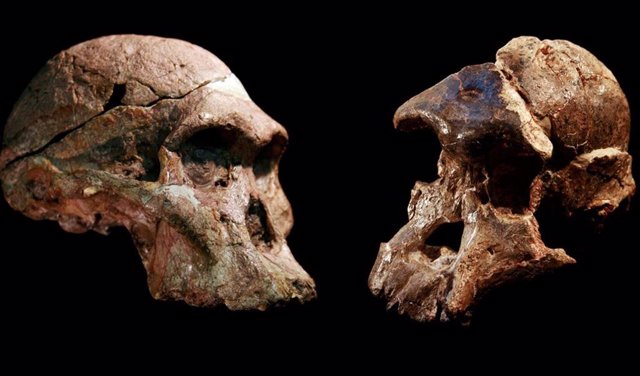Australopithecus skulls found in the Sterkfontein caves, South Africa. The Sterkfontein cave fill containing this and other Australopithecus fossils dates to 3.4 to 3.6 million years ago, much older than previously thought. – JASON HEATON AND RONALD CLARKE
June 28. () –
Fossils found in the so-called ‘Cradle of Humankind’ in South Africa could be more than a million years older than previously believed. says a new study published in PNAS.
For decades, scientists have studied these fossils of early human ancestors and their long-lost relatives. Now, a dating method developed by a geologist at Purdue University in the United States has just pushed back the age of some of these fossils found in the Sterkfontein cave site by more than a million years. This would make them older than Dinkinesh, also called Lucy, the world’s most famous Australopithecus fossil.
The ‘Cradle of Humankind’ is a UNESCO World Heritage Site in South Africa comprising several fossil cave sites, including the Sterkfontein Caves. Sterkfontein became famous for the discovery of the first adult Australopithecus, an ancient hominid, in 1936.
Hominids include humans and our ancestral relatives, but not the other great apes. Since then, hundreds of Australopithecus fossils have been found there, including the well-known Mrs. Ples, and the nearly complete skeleton known as Little Foot. Paleoanthropologists and other scientists have been studying Sterkfontein and other cave sites in the Cradle of Humankind for decades to shed light on human and environmental evolution over the past 4 million years.
Darryl Granger, a professor of earth, atmospheric and planetary sciences in the Purdue University School of Science, is one such scientist, working on an international team. Granger specializes in dating geological deposits, including those in caves.
As a doctoral student, he devised a method for dating sediments buried in caves that is now used by researchers around the world. His earlier work at Sterkfontein dated the Little Foot skeleton to about 3.7 million years old, but scientists are still debating the age of other fossils at the site.
Granger and a team of scientists, including researchers from the University of the Witwatersrand (South Africa) and Toulouse Jean Jaurès University (France), have found that not only Little Foot, but all of the cave sediments containing Australopithecus , they are between 3.4 and 3.7 million years old, instead of between 2 and 2.5 million years, as previously thought.
That age places these fossils toward the beginning of the Australopithecus era, rather than near the end. Dinkinesh, who hails from Ethiopia, is 3.2 million years old, and his species, Australopithecus africanus, dates back about 3.9 million years.
Sterkfontein is a deep and complex cave system that preserves a long history of hominin occupation of the area. Understanding the dates of the fossils here can be tricky, as the rocks and bones fell to the bottom of a deep hole in the ground, and there are few ways to date the cave sediments.
In eastern Africa, where many hominin fossils have been found, volcanoes in the Great Rift Valley deposit layers of ash that can be dated. Researchers use those layers to estimate how old a fossil is.
In South Africa, especially in a cave, scientists don’t have that luxury. They often use other animal fossils found around the bones to estimate their age or the calcite flowstone deposited in the cave. But bones can be displaced in the cave and young limestone can be deposited in old sediments, making these methods potentially wrong.
A more precise method is to date the rocks in which the fossils were found. The material that Granger and her team analyze is the concrete matrix that encases the fossil, called the breccia.
“Sterkfontein has more Australopithecus fossils than anywhere else in the world,” Granger explains. it’s a statement–. But it is difficult to date them well. People have looked at animal fossils found near them and compared the ages of cave features such as flow stones and come up with a number of different dates. Our data resolves these controversies. It shows that these fossils are ancient, much older than we first thought“, Add.
They used accelerator mass spectrometry to measure radioactive nuclides in rocks, as well as geological mapping and a deep understanding of how cave sediments accumulate to determine the age of the Australopithecus-bearing sediments at Sterkfontein.
Granger and the Purdue Rare Isotope Measurement Laboratory (PRIME Lab) research group are studying so-called cosmogenic nuclides and what they can reveal about the history of fossils, geological features and rocks. Cosmogenic nuclides are extremely rare isotopes produced by cosmic rays. high-energy particles that constantly bombard the Earth.
These cosmic rays have enough energy to trigger nuclear reactions inside rocks at the ground surface, creating new radioactive isotopes inside mineral crystals. An example is aluminum-26: aluminum that is missing a neutron and slowly decays to magnesium over millions of years.
Since aluminum-26 forms when a rock is exposed at the surface, but not after it has been deeply buried in a cave, researchers at the PRIME lab can date cave sediments (and the fossils they contain) by measuring the levels of aluminum-26 along with another cosmogenic nuclide, beryllium-10.
In addition to new dates at Sterkfontein based on cosmogenic nuclides, the research team carefully mapped the cave deposits and showed how animal fossils of different ages would have been mixed together during excavations in the 1930s and 1940s. which led to decades of confusion with previous ages.
“What I hope is that this will convince people that this dating method gives reliable results,” says Granger. “Using this method, we can more accurately place ancient humans and their relatives in the correct time periods, in Africa and in other parts of the world.
The age of the fossils is important because it influences scientists’ understanding of the vital landscape of the time. How and where humans evolved, how they fit into the ecosystem, and who they are and were their closest relatives are pressing and complex questions. Placing the Sterkfontein fossils in their proper context is one step in solving the whole puzzle, they conclude.














Add Comment